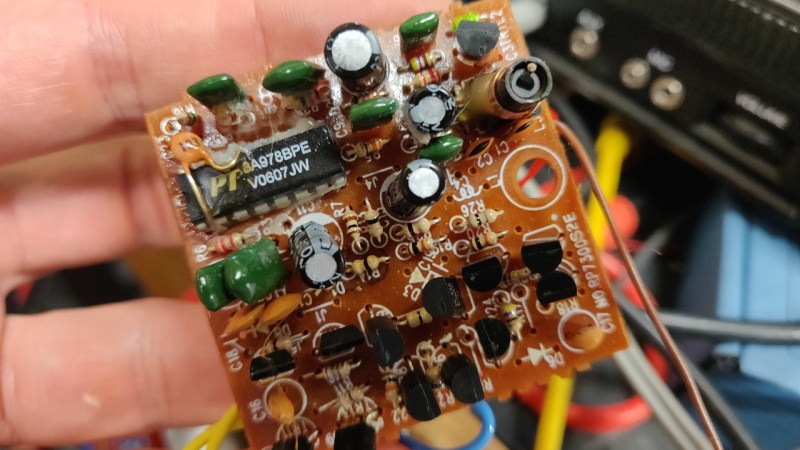The cheap little RC cars are abundant anywhere you are, and if you’ve ever disassembled one, you are familiar with how the PCB looks. A single-sided phenolic paper PCB with a mystery chip driving a bunch of through-hole transistors, a sprinkle of through-hole capacitors, and a few supporting components for the wire antenna. It might not feel reusable, but [Chris Jones] begs to differ, with a Twitter thread showing us how he’s paired a scrap board from one RC car with a remote control from another, all to help a little family project.
These mystery ICs turn out to be RC-car-on-a-chip modules, and Chris lucked out in that his IC has a detailed datasheet available, complete with code pulse examples for different commands. The datasheet for the chip in the remote control is nowhere to be found, though, so we have to dig deeper. How about scoping the RF output? Turns out the supported codes between the two ICs are basically identical! The scrap board wouldn’t move any motors though, so it was time to narrow down the issue.
The RC car board has a 128KHz oscillator, and scoping that has shown the issue – it was producing 217KHz for some reason. It turned out that the oscillator’s load resistor was 100 kiloohms instead of recommended 200k, and switching that put it back on course. We would assume that, wherever the original remote control for that car is, it is similarly mis-tuned, or otherwise the RC car could never have worked.
Through sheer luck and tactical application of an oscilloscope, the RC car moves again, paired to a remote it was never meant to be, and the family project moves forward. Got a RC car, but no remote? Perhaps a HackRF can help.

















If only ESP32 allowed ad-hoc links, making new remote transmitters and receivers for various toys with a potentially huge number of channels would be almost trivial.
Ohhh, hmmm, what about ESP-Now?
Or Arduino RCLib on Nrf24 :) Maybe more Range..
Too bad that Twitter threads are inaccessible without an account :(
For those looking for the datasheet, the IC is a PT8A978. Seems to be obsolete, but I wonder if there are any Chinese drop-in replacements.
Second that! This is the first time I remember Hackaday linking to a source story on another site that is essentially behind a wall. I probably have a dormant twitter account I could use to log it, but I am less then plussed about trading personally identifying surveillance in order to see an otherwise interesting story.” Sure, journalists link to individual tweets all the time, no problem. What makes this different is that the story depends on access to the whole series of tweets for completeness.
cant read that twitter link :(
>The datasheet for the chip in the remote control is nowhere to be found,
how about https://html.alldatasheet.com/html-pdf/155401/PERICOM/PT8A978P/295/1/PT8A978P.html ?
or this 9 year old YT video https://www.youtube.com/watch?v=pZ0StOheow4
There’s a cheap receiver transmitter pair available from the usual sources in the 8$ range (might’ve included a basic controller). I’ve got one on the workbench for an old NewBright with no controller; I’ll send the article over when I get to it.
Just a heads up: An RC car does not have a remote, but a transmitter or maybe a controller. Remotes are for TVs.
In the UK, ‘RC’ stands interchangeably for Remote Control….